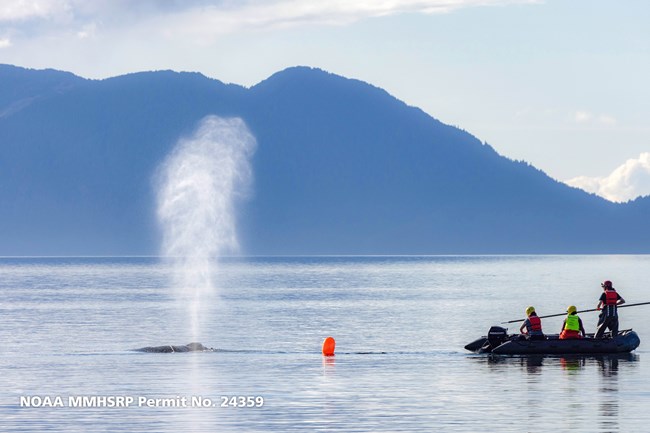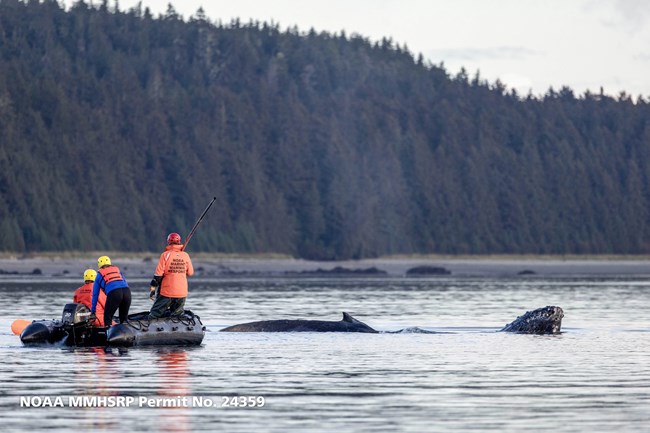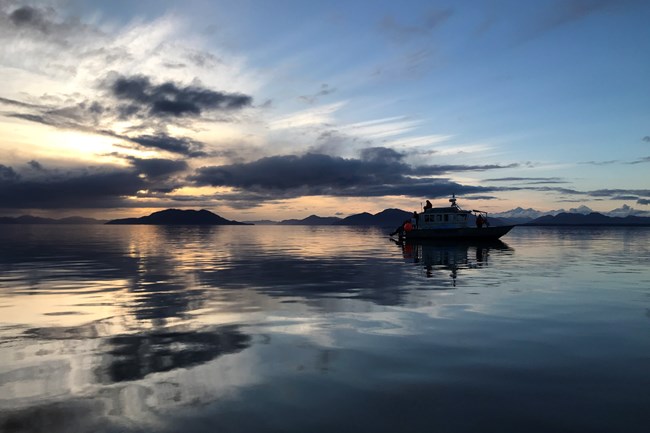Last updated: November 14, 2023
Article
Humpback Whale Freed from Entanglement Near Glacier Bay

Team of National Park Service staff collaborated with NOAA and whale experts to free entangled humpback whale near Glacier Bay National Park and Preserve
Humpback whale season was winding down in Icy Strait when the dreaded call came in on Tuesday October 10, 2023 – local residents Sesylia Hazen and Kamille Williams phoned the Glacier Bay National Park’s Visitor Information Station to report a whale near the Gustavus dock that was trailing two buoys, making unusual sounds and having trouble moving freely. National Park Service (NPS) whale biologists Janet Neilson and Chris Gabriele were brought into the loop and immediately began consulting with their colleagues in the NOAA Alaska Large Whale Entanglement Response network. It soon became apparent that there were more questions than answers - more information was needed.
Park staff went quickly to the dock with spotting scopes and cameras with powerful lenses to confirm what kind of whale it was and to gather more details on the entanglement. By early afternoon, two trained disentanglement responders (park ranger Bethany Robichaud and wildlife biologist Tania Lewis) were on their way to the scene just outside the park in the NPS patrol vessel Talus, along with ranger Alison Richardson, to better document the whale’s condition. Since 2005, the Large Whale Entanglement Response network has offered whale disentanglement training in several Alaska communities. The network currently contains approximately 150 active members, including several NPS staff at Glacier Bay.
The Talus crew observed a humpback whale swimming in a tight clockwise circle that appeared to be intermittently anchored to the seafloor by what we later learned was a 300-pound crab pot with 450 feet of heavy duty line.


The owner of the gear graciously supplied these crucial details when the NPS contacted them. The pot, which they had set near Pleasant Island, had gone missing sometime between Saturday morning and Sunday morning, meaning the whale had already been entangled for at least three days when it was reported. All of this information was evaluated by the Response Network team and led to the decision that a disentanglement effort was warranted. A rescue effort was authorized by NOAA’s Alaska Large Whale Entanglement Response Coordinator, Sadie Wright. Gale force winds were forecast for later in the week and daylight hours were short, however there was one more fair weather window the following day to attempt to disentangle the whale. But assembling the team was another challenge.
By coincidence, highly skilled whale disentanglement expert, Dr. Fred Sharpe from the Alaska Whale Foundation, had just arrived in Juneau and was available to fly to Gustavus the next day. Sharpe agreed to lead a team that included Janet, Chris, Tania, and Bethany, along with captain Justin Smith on the NPS research vessel Capelin. FAA licensed drone pilot Sean Neilson volunteered to fly to take aerial imagery to help clarify how the whale was tangled. The video and still images he collected proved to be essential to understanding how the whale was entangled and making a strategy to cut it free.
The next morning, when Alaska Seaplanes pilot Brandon Warren learned that he was carrying a whale response team from Juneau to Gustavus, he offered to keep a lookout for the whale on the approach to Gustavus. As everyone on the small plane peered out the windows searching for the whale, passenger Marc Heifetz (USGS) exclaimed that he had spotted the buoys and the whale very close to the shore of Pleasant Island, about a mile from where it had been the previous day. This saved precious time that the team would need to try and rescue the whale. By 11am, the response team on the Capelin was with the whale, towing a NPS inflatable boat with a small outboard motor that the team would need to safely get close to the whale. After weeks of storms and rain, the weather was perfect with flat calm seas and sunny skies.
The video below gives you an idea of the seriousness of the scenario and the challenges faced by the rescue team.
- Duration:
- 39.6 seconds
Entangled humpback whale near Pleasant Island, Icy Strait, Alaska. October 11, 2023. Footage by Sean Neilson. Imagery contained in this video was taken pursuant to and under the authority of NOAA Fisheries’ Marine Mammal Health and Stranding Response Program Permit No. 24359.

The whale still had limited mobility and was swimming in clockwise circles. It was making 7-9 minute dives and was at the surface for only about 30 seconds. The footage from the drone soon revealed why. The whale had a loop of line through its mouth that led to a large, heavy glob of tangled lines at its tail. In effect, the whale was hog-tied, its body bent sharply to the side as it swam in a predictable clockwise circle each time it came up. The whale also had a distinct healed scar across its back from being hit by a vessel’s propeller; this past injury was unrelated to the entanglement.

For the first hour on scene, the whale was energetic, circling and evading the rescuers, but soon it became a little more accustomed to the inflatable.

Eventually, the team was able to seize a few critical opportunities to make cuts in the line using a specially designed knife mounted on a very long pole. Check out the video below for footage of this complex and challenging situation.
- Duration:
- 45.633 seconds
Humpback whale disentanglement near Pleasant Island, Icy Strait, Alaska. October 11, 2023. Footage by Sean Neilson. Imagery contained in this video was taken pursuant to and under the authority of NOAA Fisheries’ Marine Mammal Health and Stranding Response Program Permit No. 24359.

Part of the safety protocol for this risky operation is regular consultation with NOAA response coordinators. Throughout the event, we kept in regular contact with one of the world’s leading whale disentanglement experts, Ed Lyman, Regional Large Whale Entanglement Response Coordinator from the Hawaiian Islands Humpback Whale National Marine Sanctuary in Maui. Ed acts as a Regional Large Whale Entanglement Response Coordinator under NOAA’s Marine Mammal Health and Stranding Response Program. Fortunately, there was cell phone service in the area of the response, making it possible to have conversations and share images throughout the process.

The team worked with the whale all day until daylight was disappearing, using specialized tools to remove more of the gear while remaining at a distance from the whale.

Photos taken by Sean’s drone and the Capelin team later confirmed that by the end of the effort, the whale had no line left around its tailstock, and that the loop through its mouth had been cut. The whale maintained its curved posture after the lines were cut, but biologists expect that it returned to a more normal form once it was able to move freely again.


NPS Photo / C. Gabriele, NMFS Scientific Research Permit No. 27027
The next day, using photos collected during the effort, Janet was able to identify the whale as SEAK-5490, who was new to the Glacier Bay area in 2023 (see inset photo taken in July 2023 in Icy Strait), but had been seen elsewhere in Southeast Alaska in 2021 and 2022 and was first documented by the Alaska Whale Foundation in Frederick Sound.
Last fall, Alaska Whale Foundation / University of Hawaii researcher Martin van Aswegen used a drone to measure the length of this whale at 32.5 ft (9.9 m). This suggests that SEAK-5490 is a juvenile whale, currently estimated to be 3-4 years old based on measurements of other young Alaska humpbacks.
Knowing the identity of the entangled whale is crucial information that will allow us to confirm this whale’s survival and track its whereabouts. We look forward to future sightings in the coming months and years. You can view sightings of SEAK-5490 and “follow” this whale to be notified when it is next sighted on Happywhale.com.
As you can see from this story, and the NOAA web story about this entanglement it not only takes a lot of teamwork, but a team with the right training and equipment, to safely disentangle a whale. If you encounter an entangled whale or other marine mammal, it is important not to try to cut it free, for your own safety and the whale’s safety. Also, it takes specialized tools and training to remove all of the life-threatening gear from a whale. Well-meaning people who cut off buoys trailing behind a whale actually worsen the whale’s chances of survival. Taking just the trailing buoys off while leaving lethal lines or net around the whale’s body make it harder to re-locate the animal and impossible to attach a satellite tag buoy that responders use to track the whale while they plan their rescue efforts. Disentanglement is a highly specialized skill as there are inherent risks when working with a 35-ton whale in distress. Due to the specialized skills needed, disentangling a large whale is a permitted activity overseen nationally under the authority of NOAA’s Marine Mammal Health and Stranding Response Program. So, what CAN you do to help?
If you see a stranded, injured, entangled or dead marine mammal in Alaska, immediately call the statewide 24-hour stranding hotline at 877-925-7773 or call the U.S. Coast Guard on VHF channel 16. If you are interested in learning more about whale disentanglement training in your community, start by taking NOAA’s online First Responder Training. Together we can better understand and conserve the whales in our backyards and other precious marine life.
This response was authorized under the authority of NOAA Fisheries’ Marine Mammal Health and Stranding Response Program Permit No. 24359.
Note: markings on buoys have been removed from photos for the privacy of their owner(s).

Photo by Sean Neilson, NOAA MMHSRP Permit No. 24359
